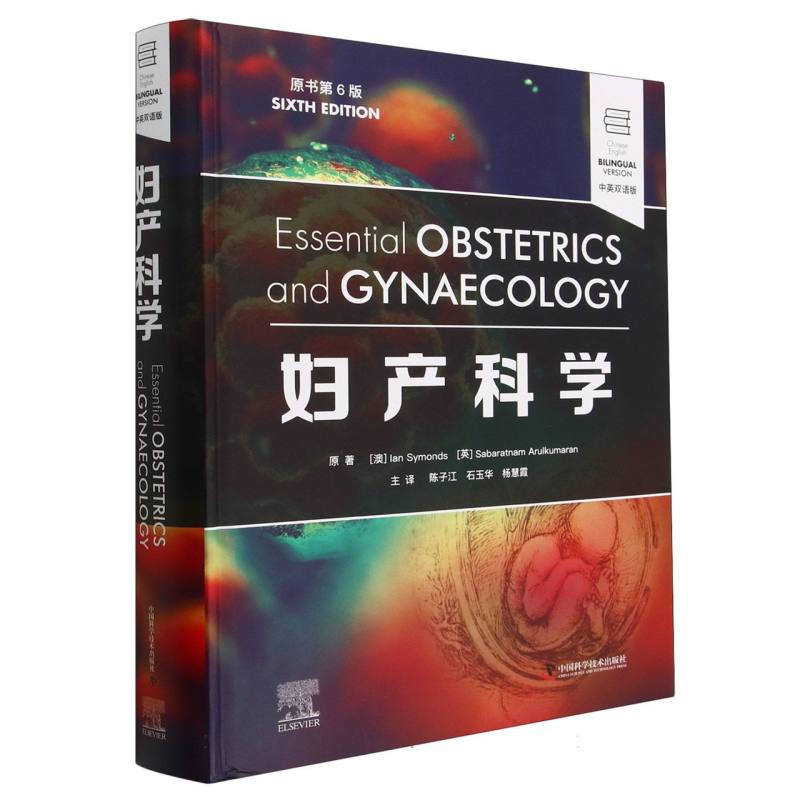
出版社: 中国科学技术
原售价: 458.00
折扣价: 311.50
折扣购买: 妇产科学(原书第6版·中英双语)
ISBN: 9787504698926

原著者:Ian Symonds,南澳大利亚州阿德莱德妇女儿童医院产科客座医学专家,阿德莱德医学院院长,阿德莱德医科大学院长;Sabaratnam Arulkumaran,英国伦敦伦敦圣乔治大学妇产科部名誉教授。主译:陈子江,中国科学院院士;石玉华,教授,主任医师,广东省人民医院妇产科;杨慧霞,教授,主任医师,北京大学第一医院妇产科。
第 2 章? ? 妊娠与着床 Conception and implantation Roger Pepperell 著 刘培昊 宋晓翠 译 石玉华 校 学习目标 学习本章后你应当能够: 知识标准 描述配子形成的基本原理 描述正常月经周期的生理 描述性交、受精和着床的生理临床能力 为夫妇提供关于受孕时期的建议 LEARNING OUTCOMES After studying this chapter you should be able to: Knowledge criteria Describe the basic principles of the formation of the gametes Describe the physiology of the normal menstrual cycle Describe the physiology of coitus, fertilization and implantation Clinical competency Counsel a couple about the fertile period 一、卵子发生(Oogenesis) 原始生殖细胞最初出现在卵黄囊内,胚胎发育第 4 周可被识别(图 2-1)。胚胎发育 44~48 天,原始生殖细胞通过发育中的肠的背系肠系膜迁移至生殖嵴。进入含有间充质细胞的生殖结节,间充质细胞出现在中肾的腹侧。生殖细胞形成性索,后发育为卵巢皮质。 Primordial germ cells originally appear in the yolk sac and can be identified by the fourth week of fetal development (Fig. 2.1). These cells migrate through the dorsal mesentery of the developing gut and finally reach the genital ridge between 44 and 48 days post-conception. Migration occurs into a genital tubercle consisting of mesenchymal cells that appear over the ventral part of the mesonephros. The germ cells form sex cords and become the cortex of the ovary. 性索随后分裂为单独的细胞团,至胚胎 16 周时,这些细胞团发育为初级卵泡,包括中央生殖细胞。 The sex cords subsequently break up into separate clumps of cells and, by 16 weeks, these clumped cells become primary follicles, which incorporate central germ cells. 这些细胞进行快速的有丝分裂,在宫内妊娠 20周时数目约 700 万,被称为卵原细胞。此后,细胞不再进一步分裂,也不再产生。出生时,卵原细胞就已开始减数第一次分裂,成为初级卵母细胞。初级卵母细胞数量逐渐减少,到出生时减少至约 100 万个,到青春期时减少至约 40 万个。 These cells undergo rapid mitotic activity, and by 20 weeks of intrauterine life, there are about 7 million cells, known as oogonia. After this time, no further cell division occurs and no further ova are produced. By birth, the oogonia have already begun the first meiotic division and have become primary oocytes. The number of primary oocytes falls progressively and by birth is down to about 1 million and to about 0.4 million by puberty. 1. 减数分裂(Meiosis) 减数分裂过程使每个配子中有 23 条染色体,是正常细胞染色体数目的 1/2。随着卵子被精子受精,染色体数目恢复至正常的 46 条。精卵结合发生在卵母细胞第一次减数分裂完成时;第二次减数分裂于雄配子的 23 条染色体在细胞核内混入雌配子染色体前完成,随后受精卵形成,将发育为胚胎。 The process of meiosis results in 23 chromosomes being found in each of the gametes, half the number of chromosomes found in normal cells. With the fertilization of the egg by a sperm, the chromosome count is returned to the normal count of 46 chromosomes. Fusion of the sperm and the egg occurs when the first of two meiotic divisions of the oocyte has already been completed; with the second meiotic division occurring subsequently and being completed prior to the 23 chromosomes of the male gamete joining those of the female gamete within the nucleus of the cell, the zygote is formed, which will become the embryo. 在减数分裂过程中,连续发生 2 次细胞分裂,每次均分为前期、中期、后期和末期。2 次细胞分裂中的第一次为减数分裂,第二次为改良有丝分裂,通常缺乏前期(图 2-2)。在第一次减数分裂前期末,双染色体联会,产生 1 组 4 个同源染色单体,称为四分体。2 个中心粒运动至相反的两极。中间形成纺锤体,核膜消失。在减数分裂Ⅰ前期,同源染色体沿整个长度成对进行联会,交叉并进行染色单体交换,这个过程解释了尽管雌配子来源于同一位母亲,两个同性兄弟 / 姐妹间仍存在差异。 In meiosis, two cell divisions occur in succession, each of which consists of prophase, metaphase, anaphase and telophase. The first of the two cell divisions is a reduction division, and the second is a modified mitosis in which the prophase is usually lacking (Fig. 2.2). At the end of the first meiotic prophase, the double chromosomes undergo synapsis, producing a group of four homologous chromatids called a tetrad. The two centrioles move to opposite poles. A spindle forms in the middle, and the membrane of the nucleus disappears. During this prophase period of meiosis I, the double chromosomes, which are closely associated in pairs along their entire length, undergo synapsis, crossing over and undergoing chromatid exchange, with these processes accounting for the differences seen between two same-sex siblings despite the fact that the female gametes came from the same mother. 初级卵母细胞保持分裂前期直至性成熟,或更晚至黄体生成素(luteinizing hormone,LH)触发优势卵泡排卵,才自减数分裂Ⅰ开始进展。在减数分裂后期,子染色单体分离并向相反两极移动。减数分裂Ⅱ自精子黏附在卵母细胞表面开始,并在受精的最后阶段前完成。 The primary oocytes remain in suspended prophase until sexual maturity is reached, or even much later, with meiosis I not recommencing until the dominant follicle is triggered by luteinizing hormone (LH) to commence ovulation. In anaphase, the daughter chromatids separate and move towards opposite poles. Meiosis II commences around the time the sperm are attached to the surface of the oocyte and is completed prior to the final phase of fertilization. 因此,卵子发生的核内事件与精子发生中的基本相同,但卵子发生中细胞质分裂不均等,只产生 1个次级卵母细胞。第一次减数分裂后的这个几乎完全由细胞核组成的小细胞,称为第一极体。当卵子进入输卵管时,减数第二次分裂发生,形成次级卵母细胞,同时产生小的第二极体。男性最初细胞内含 46 条染色体,最终形成 4 个精子,大小相同,但每个精子仅含 23 条染色体(见后文精子发生)。 Thus, the nuclear events in oogenesis are virtually the same as in spermatogenesis, but the cytoplasmic division in oogenesis is unequal, resulting in only one secondary oocyte. This small cell consists almost entirely of a nucleus and is known as the first polar body. As the ovum enters the Fallopian tube, the second meiotic division occurs and a secondary oocyte forms, with the development of a small second polar body. In the male the original cell containing 46 chromosomes ultimately results in four separate spermatozoa, each being of the same size but containing only 23 chromosomes (see Spermatogenesis, later). 临床场景、要点、图表等内容丰富,是教科书级别的妇产科著作